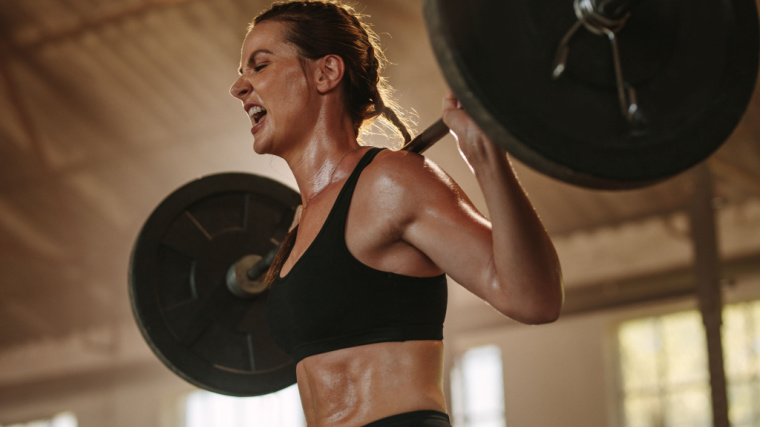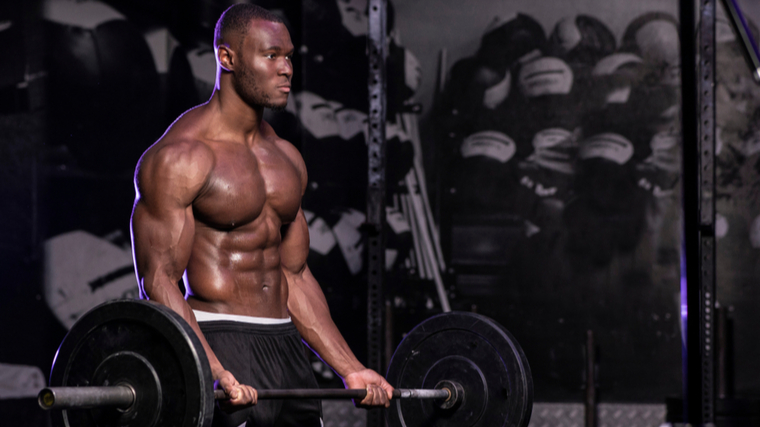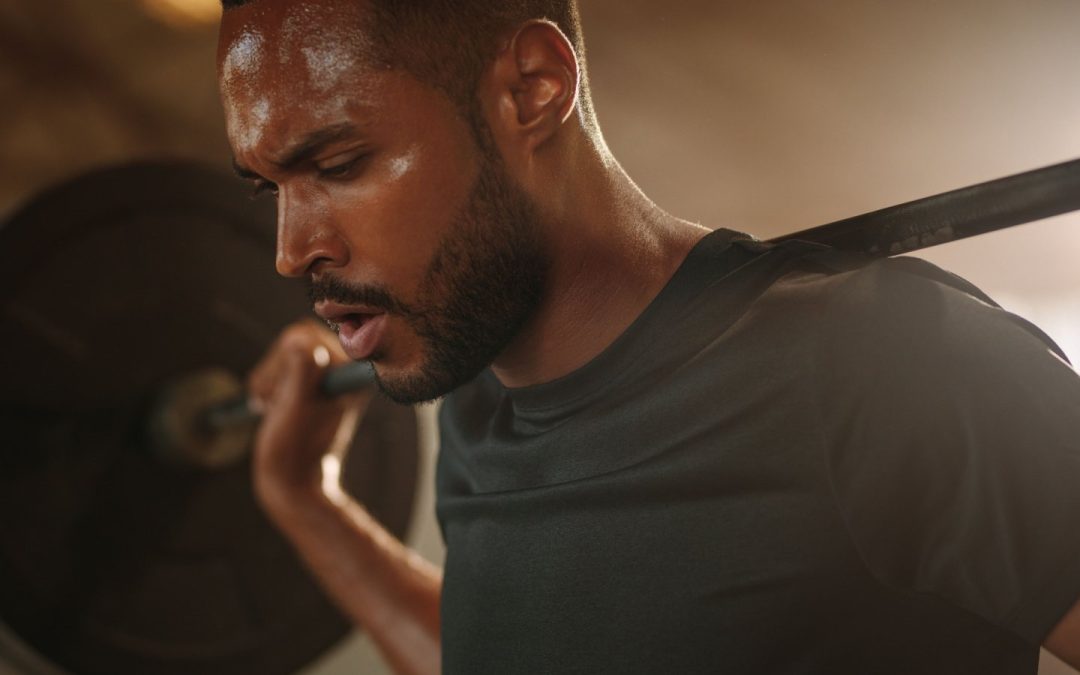Tell an experienced lifter to do 20 reps of curls and they’ll say it’s too easy. Tell them to do 20 reps of pull-ups and they’ll say it’s too hard. Tell them to do 20 reps of squats and, if they know their stuff, they’ll start to tremble.
The 20-rep squat program has a long and fabled history in the strength and fitness community because it emphasizes the basics: the classic barbell back squat, plenty of hard work, and a fair amount of mental and physical endurance.

This time-tested plan is sometimes referred to as “the squats and milk program” due to the abundant whole milk consumption typically considered part and parcel with the massive leg exercise. Here’s a look at how and why this training strategy has been a reliable staple for nearly a century.
The 20-Rep Squat Program
- History of the 20-Rep Squat Program
- How to to Program 20-Rep Squats
- Benefits of 20-Rep Squats
- Drawbacks of the 20-Rep Squat Program
- Sample 20-Rep Squat Program
- Frequently Asked Questions
History of the 20-Rep Squat Program
In today’s age of quick fixes and training hacks peddled by online “fitfluencers,” it might be hard to believe that one specific workout program originated in the 1930s and continues to be promoted as a viable routine in the 21st century. However, that’s exactly the case with 20-rep squats. The program was first popularized back when Babe Ruth was calling his shot. It had a resurgence in the ‘80s and the plan continues to be a go-to solution for building size and strength relatively quickly.
Training in the 1930s
From 1914 to 1935, Strength magazine, known informally as “America’s First Muscle Magazine,” was a monthly publication. It featured fitness and nutrition advice collectively known at the time as “physical culture,” rather than “bodybuilding” or “powerlifting” since those activities hadn’t yet formally begun.
Mark Berry was the magazine’s editor from 1927 until the its bankruptcy in 1935. Berry was also an Olympic weightlifter and national weightlifting coach for the 1932 and 1936 Olympic teams. He used the magazine to advocate for, among other tactics, high-repetition barbell squatting for adding muscular bulk and strength.
The training program was built around one centerpiece exercise — the back squat — with very few additional exercises, mainly to address the torso and arms. This type of abbreviated training plan was performed two or three days per week, allowing rest and recovery on the remaining days.
The minimalist training was complemented by high-calorie foods to fuel muscle growth. Specifically breads, fruits, eggs, and good old fashioned milk. These basic staples were generally available to most households, even as The Great Depression rolled across the country.
One of the first names associated with successfully implementing this mass-building routine was Joseph Curtis Hise, or J.C. Hise, a reader of Mark Berry’s work. Hise wrote Berry to announce his results after diligently following the 20-rep squat program. Hise gained nearly 30 pounds of muscular body weight in 30 days, and would go on to be an innovative and influential strength icon in his own right.
Continuing Berry’s work, training advice centered around high-repetition squatting would be echoed in popular fitness magazines over the decades to follow. Most notable was Peary Rader’s Iron Man magazine in the 1960s, where strength advocate and columnist John McCallum would continue preaching the protocol’s benefits. The training tides might’ve ebbed and flowed, but the 20-rep squat program continued to be a mainstay in the weight room.
“Super Squats” and the ‘80s Fitness Craze
The 1980s were a relatively wild time in the fitness world. Arnold Schwarzenegger and Sly Stallone made muscular physiques mainstream in Hollywood; legwarmers and leotards filled commercial gyms; and follow-along workout videotapes made their way into homes.
People were getting their training guidance from an array of newsstand magazines, VHS cassettes, and workout books often emphasizing aerobics and extreme calorie restriction. In a likely welcomed change of pace, one book in particular hit the shelves in 1989 — “Super Squats” by Randall J. Strossen, Ph.D.
“Super Squats” featured the eye-catching (though debatably accurate) subtitle: “How to Gain 30 Pounds of Muscle in 6 Weeks.” This was a clear testament to the significant gains and relatively short timeframe commonly associated with the 20-rep squat program.
In his book, Strossen recalled the lessons of Berry, Hise, and those who came before him in the lifting world. He also re-introduced the 20-rep squat program itself, in detail, while presenting related ideas such as the importance of proper diet, ample rest, and even a section discussing the correct attitude and mindset for the challenging routine.
While plenty of emphasis was placed on the thrice-weekly training sessions, just as much discussion was given to realistic goal-setting, tracking progress, and building the self-motivation and mental toughness needed to complete all 20 repetitions.
More than 30 years since its first printing, Strossen’s book remains on the “suggested reading” list of many strength coaches, personal trainers, and experienced lifters in large part to its continued relevance and applicable lessons.
How to Program 20-Rep Squats
The 20-rep squat program has a few fundamental, non-negotiable aspects as well as general principles that could allow a degree of flexibility.
Breathing Squats
Performing a typical set of 20 repetitions is usually a fairly straightforward scenario. Whether it’s a push-up, lat pulldown, or dumbbell curl, you typically just lift and lower the weight consistently until the set is completed.
However, with the 20-rep squat program, you’re not simply performing a set of squats for 20 reps. You’re performing breathing squats, so named because deliberate, deep breathing is a mandatory part of the exercise technique.
Rather than exhaling while exerting force and inhaling as you lower the weight, or bracing your core throughout the movement and quickly stealing a mini-breath between repetitions, a set of breathing squats is done with very intentional breathing — fully exhaling and fully inhaling multiple times— between individual reps.
This extends the overall duration of the set, keeping the weight on your back for minutes at a time. A long duration set means your body stabilizers are put through a long time under tension which may help to trigger systemic muscle growth. (1) Interestingly, and perhaps not surprisingly, modern sports science research has validated the potential muscle- and strength-building benefits of this type of mid-repetition resting protocol. (2)

As one might expect, several permutations of breathing squats have been attempted over the years, manipulating the breathing patterns with the loading and repetition performance. Two primary methods have remained.
Breathing squats can be done with multiple deep breaths between each individual repetition. This is a more traditional method, in line with Berry’s original recommendation. After unracking the bar and setting up your stance, take two or three deep diaphragmatic breaths before performing the first repetition. Upon locking out in the standing position, take two or three breaths before performing the next rep. This pattern is continued until 20 squats have been performed.
This approach is very similar to the “cluster rep” technique and helps to maintain performance for longer duration sets. The set of “20 reps” can almost be approached as 20 individual repetitions (without racking the bar between each repetition). This can help to ensure optimal technique and focus. It also accommodates lifters of any strength level and can be performed with any weight, unlike the next breathing squat alternative.
Perform a 10-repetition maximum lift with standard technique, taking deep breaths from reps 11 to 20. This approach requires the lifter to load their 10-repetition max (10RM) on the bar and perform a straightforward set of 10 reps with a typical breathing pattern. Upon reaching muscular failure, rather than re-rack the weight, the lifter stands in the locked out position and takes three to five deep diaphragmatic breaths before performing an eleventh rep.
Upon lockout, take another three to five deep breaths before rep number 12. Repeat this grueling process until you stand up with the twentieth rep, before gratefully racking the bar. For many lifters, this “do 20 reps with your 10RM” method is the more challenging version because it requires taking the movement to muscular failure before continuing the set one arduous squat at a time. It’s not uncommon for lifters to simply be unable to complete all 20 repetitions with this approach.
Assistance Exercises
While the barbell back squat is the training priority of any 20-rep squat program, additional movements are needed to address the rest of the body.
Typically these movements focus on the upper body with little to no added lower body exercises. Performing an excessive amount of assistance exercises would increase fatigue and decrease recovery ability without contributing significantly to results.

In the early days of Mark Berry and J.C. Hise, the squat was complemented by the behind-the-neck shoulder press, barbell curl, and barbell pullover. This barebones plan allowed lifters to focus their energy on completing the squat portion first and foremost, with the supplemental exercises rounding out a very simplified “full-body workout” by training the chest, back, shoulders, and arms with the chosen exercises.
Strossen offered two detailed workouts in “Super Squats.” The “basic routine” was quite comprehensive and included the behind-the-neck press, bench press, barbell row, barbell curl, squat, a pullover variation, stiff-leg deadlift, calf raise, and crunch.
The book also offered an “abbreviated program” for lifters who had particular trouble gaining body weight on the expansive basic routine. This condensed program required simply the bench press, squat, barbell row, and a specialized pullover variation known as a “Rader chest pull” — essentially a standing, static/isometric exercise that mimicked the mid-point of a pullover.
The common thread with any assistance training was to primarily target the upper body with a “pushing” exercise, a “pulling” exercise, and some type of pullover. The pullover, in particular, was often suggested to “expand” the lifters’ ribcage. While there’s no anatomical way for that to occur, the exercise does efficiently target the back, chest, shoulder, and triceps muscles, making it an excellent choice for overall upper-body growth.
Two to Three Workouts Per Week
The nature of the 20-rep squat program — full-body workouts performing the squat in every session — allows three concentrated training days with four days of rest.
For lifters with a poor recover capacity or those who perform significant physical activity outside the gym (such as a career in manual labor or playing rec-league sports), two training days could yield better overall results.

This can be a drastic change of pace for those more accustomed to training four or five days per week with a more conventional bodybuilding-style training split. Balancing high-frequency training (working the squat in each workout) with sufficient overall recovery is critical for steadily recovering and growing during the course of the plan.
This intensity of the 20-rep squat set is so high that many lifters come to realize, “if you feel like training more days per week, you’re not pushing hard enough during the breathing squats.”
GOMAD: Gallon of Milk a Day
The 20-rep squat program isn’t designed for lifters who are looking to get lean. It’s not even necessarily for those looking to get into “bodybuilding shape” by targeting individual muscles, or lifters who want to move heavy weights and hit new PRs.
20-rep squats are used, first and foremost, to gain muscular bodyweight. That requires an abundance of high-quality calories to maximize recovery, growth, and performance in the demanding workouts. (3)
One keys to reaching the necessary (arguably excessive) calorie surplus is a habit promoted since the program’s inception: drinking a significant amount of whole milk every day, in addition to three hearty, well-balanced meals. Drinking milk instead of meals is a common but extremely counterproductive mistake made by some lifters new to the program.

Whole milk has long-been associated with building muscle. (4) It’s packed with highly efficient protein while delivering usable carbohydrates and calorie-dense fats to round out a complete nutrition profile. It’s also a relatively inexpensive way to add calories compared to whole food sources.
Liquid calories (those that are drank rather than chewed) are generally less satiating, which can make it easier for lifters to take in enough calories when their appetite might otherwise be an obstacle.
Berry’s initial recommendation was two liters (a half-gallon) each day, delivering 1,200 total calories. Strossen took a more drastic approach, suggesting lifters begin with a half-gallon daily and progress up to one full gallon per day to support significant growth.
Benefits of 20-Rep Squats
High-frequency squatting, high-calorie intake, and consistent hard work should be a reliable recipe for progress in the gym. Here’s what you can expect when you push yourself with the 20-rep squat program.
Size
This program is inherently associated with packing on pounds of muscular bodyweight. When the workouts are followed and complemented by an abundance of calories, the scale will be moving up.
Whether you’re looking to go up a weight class in a sport or trying to build a base of muscle, 20-rep squats are one of the most challenging, and most effective, bulking routines the fitness world has seen in almost a century.
Strength
Emphasizing a single lift — the back squat, in the case of the classic 20-rep squat program — is an effective way to improve strength, technique, and overall performance of that exercise. Spending four to six weeks focused on the back squat as your primary lower body exercise should carry over to improved strength gains overall.

The supportive muscles of your core and lower back also get recruited for high-frequency training. As they adapt, you’ll build strength and endurance along with the capacity to tolerate a greater workload, making them stronger stabilizers to carry over to other lifts.
Mental Toughness
This benefit might not seem as apparent or objective as muscular size or strength, but breathing squats are notorious for building mental toughness with each consecutive repetition. When you’re standing at lockout, supporting the weight across your upper back and taking each deep breath, you’re convincing yourself that you can complete just one more rep.
Repeating that positive self-talk rep after rep, and workout after workout, and week after week can have a net-positive effect on your overall mental approach to challenges, in the gym and outside of it. After some weeks of performing 20-rep squats, a “regular” hard set of deadlifts or bench presses likely won’t seem as daunting compared to the struggle of high-rep breathing squats.
Drawbacks of 20-Rep Squats
While the 20-rep squat program has survived and thrived through generations of lifters, it’s not without a few inherent issue. Here’s what to watch for before tackling this long-established training plan.
Body Fat Gain
Any type of “bulking” routine is often associated with a degree of body fat gain. While you can’t necessarily rush the process of muscle-building, you can encourage it by providing your body with an abundance of nutrients — particularly calories and protein — to create new muscle tissue.
Once the rate of muscle tissue has been met, additional nutrients will be shuttled toward stored body fat. This is sometimes seen as a “necessary evil” when the goal is overall muscular growth. While the body may only be able to build up to two to three pounds of muscle tissue per month, a caloric surplus is an efficient way to achieve the end result. (5)(6)
Before beginning the 20-rep squat routine, understand that lean ab definition is neither the goal nor the end result of the program. That may be a target for a later date, but the 20-rep squat program itself isn’t a means to that specific end.
Limited Development
Any type of minimalist program — one that uses few exercises and/or few training days per week — will knowingly compromise on overall potential development as it works along a more generally efficient training plan.

The 20-rep squat program isn’t for lifters looking to develop a necessarily fine-tuned, entirely symmetrical physique. It’s also not for lifters looking to target muscle groups with multiple exercises per session for maximum growth in a specific body part. In fact, certain muscles may go under-addressed in the short-term due to the relatively limited exercise menu of the workout plan.
This is necessary by design, since the 20-rep squat plan focuses on the squat itself and only a handful of additional exercises for several weeks. It’s acceptable that the triceps or the abdominals or the calves don’t receive direct training during the course of the plan because the focus is on successfully completing 20 reps of the squat, several times per week.
Were the program to be continued for a long-term, this could potentially raise noticeable development issues. One benefit of the training plan being intentionally a short-term training phase is that those developmental issues never come to pass.
Sample 20-Rep Squat Program
Ready to tackle this time-honored training program? Here’s a plan that’s quite in line with Berry’s original routine. Use the original breathing squat pattern — taking two to three deep breaths between each repetition in the standing, locked out position. Repeat the workout three days per week, with at least one day of rest between each session.
As a consistent means of progress, add five pounds to the squat each workout. For example, if you perform 20 reps with 185 pounds on Monday, use 190 pounds on Wednesday, 195 pounds on Friday, 200 pounds the following Monday, etc. If you fail to achieve all 20 repetitions in a workout, repeat the weight for the following session until successful.
The Classic Workout
Back Squat 1 x 20
Pullover 1 x 15-20
Romanian Deadlift 2 x 10-12
Standing Dumbbell Shoulder Press 3 x 10-12
Reverse-Grip Pulldown 3 x 10-12
Hard Work Always Pays Off
With nearly a century-long lineage, calling the 20-rep squat program “a unique experience” is an understatement. For some lifters, the routine is a rite of passage marking full-fledged entrance to intense weight training. For others, surviving a few weeks of 20-rep squats is a bucket list item to be done for bragging rights, if not size and strength. While some fitness trends come and go, this dependable training plan will continue delivering gains for generations to come.
FAQs
Do I have to perform back squats or can I use a different leg exercise?
If you want to follow the letter of the law, then yes, barbell back squats are the traditional choice for 20-rep squats. If you want to adhere to the spirit of the law, then any squat variation that allows you to safely push yourself to your limits, and beyond, can be used without sacrificing much (if any) progress.
In fact, J.C Hise didn’t use the classic barbell back squat for his impressive transformation. He machined a slight curve to his barbell so it would sit more comfortably and more ergonomically along his upper back. Several decades later, the similar “buffalo bar” or camber bar would become a somewhat commonplace barbell design allowing squatters to reduce shoulder strain and increase upper back stability.
Following his lead, using a safety squat bar or cambered bar for 20-rep squats would absolutely be acceptable. Exercises like the front squat may be problematic because holding the rack position for the extended duration will likely make upper back and core fatigue a limiting factor rather than lower body strength.
Similarly, deadlift variations would likely cause your grip and/or lower back to be the first muscle groups to fail, limiting your ability to safely achieve all 20 repetitions. Machine exercises like the leg press or hack squat virtually eliminate your upper body entirely, making them generally less efficient as the focus lift of the plan.
Do I really have to drink a gallon of whole milk a day? Would skim milk or a non-dairy alternative work?
Remember that the purpose of the milk is an inexpensive, nutrient-dense, food that’s extremely easy to get down. A full gallon is certainly not necessary — Berry advocated for half as much.
Low-fat milk options could be considered, as long as you factor in the relatively reduced calories they deliver. A half-gallon of skim milk delivers 720 calories compared to 1,200 calories of whole milk, without trading the quality protein content.
Non-dairy alternatives such as oat milk, almond milk, or soy milk would also provide significantly different nutrient levels — most notably, the quality protein that’s indispensable for muscle growth but severely lacking in many nut-based milk alternatives. Without enough high-quality protein, your body won’t have the literal building blocks needed to repair and build muscle. (7)
References
- Burd, N. A., Andrews, R. J., West, D. W., Little, J. P., Cochran, A. J., Hector, A. J., Cashaback, J. G., Gibala, M. J., Potvin, J. R., Baker, S. K., & Phillips, S. M. (2012). Muscle time under tension during resistance exercise stimulates differential muscle protein sub-fractional synthetic responses in men. The Journal of physiology, 590(2), 351–362. https://doi.org/10.1113/jphysiol.2011.221200
- Tufano, James J.1,2; Brown, Lee E.3; Haff, G. Gregory1. Theoretical and Practical Aspects of Different Cluster Set Structures: A Systematic Review. Journal of Strength and Conditioning Research 31(3):p 848-867, March 2017. | DOI: 10.1519/JSC.0000000000001581
- Slater, G. J., Dieter, B. P., Marsh, D. J., Helms, E. R., Shaw, G., & Iraki, J. (2019). Is an Energy Surplus Required to Maximize Skeletal Muscle Hypertrophy Associated With Resistance Training. Frontiers in nutrition, 6, 131. https://doi.org/10.3389/fnut.2019.00131
- Roy B. D. (2008). Milk: the new sports drink? A Review. Journal of the International Society of Sports Nutrition, 5, 15. https://doi.org/10.1186/1550-2783-5-15
- Thomas, M. H., & Burns, S. P. (2016). Increasing Lean Mass and Strength: A Comparison of High Frequency Strength Training to Lower Frequency Strength Training. International journal of exercise science, 9(2), 159–167.
- Brett A. Dolezal and Jeffrey A. PotteigerJournal of Applied Physiology 1998 85:2, 695-700
- Tagawa, R., Watanabe, D., Ito, K. et al. Synergistic Effect of Increased Total Protein Intake and Strength Training on Muscle Strength: A Dose-Response Meta-analysis of Randomized Controlled Trials. Sports Med – Open 8, 110 (2022). https://doi.org/10.1186/s40798-022-00508-w
Featured Image: Jacob Lund / Shutterstock

